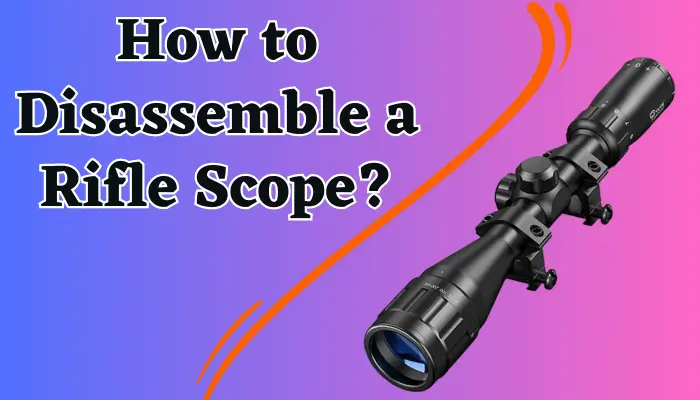This post may contain affiliate links which means I may receive a small commission for purchases made through the links. Learn More
Wear and tear is common in outdoor tools no matter if they belong to high-end scopes or cheaper binoculars. You’ll have to fix it so that they remain with you for years to come. Even if they don’t show any wear or tear, you’ll have to clean them to ensure that they remain in good condition.
Riflescopes are usually used in outdoor conditions, and chances are high that the dust, and debris will affect the scope’s performance. So, it is important for you to keep them clean and under your check. To clean, fix or repair, you’ll have to disassemble your binoculars. But do you know how will you do that?
If you don’t know, you’re not alone! There are many outdoor enthusiasts who don’t know much about how they can disassemble their scops to get them fixed. In this article, I will provide a step-by-step guide on how to disassemble a rifle scope. So, let’s drill down.
Related Article: Why Are Trijicon Acog Scopes So Expensive?
Required Tools
Before starting to disassemble a rifle scope, one needs to gather the necessary tools. If you don’t have the required tools, I don’t recommend you disassemble your scopes as you won’t be able to complete the whole process.
- Screwdriver Set
- Pliers to grip small parts and remove them from the scope.
- Allen Wrench Set
- Tweezers as they will help you handle small components or reticles.
- Work Mat will help you keep all the disassembled components in one place.
Although these tools are important you cannot ignore the importance of well-lit workspace. A workspace with good lighting will help in identifying small parts and screws. A clean workspace will help in keeping the parts organized and prevent any loss of parts.
Major Components to Disassemble
I know the disassembling process can be a bit confusing. But my efforts will be to make it simple and help you understand everything. So, it is very important to know the exact components that are supposed to be disassembled if you want to fix, repair to even clean the riffle scope. Here is the list of important components:
- Turrets
- Reticle
- Objective lens
- Eyepiece
How to Disassemble a Rifle Scope?
Disassembling a rifle scope can be a bit tricky task for those who are not familiar with the process. But you don’t need to worry as I have got your back. In the section below, I will give you easy-to-follow smaller steps (you can baby steps) that will help you in disassembling the components of the rifle scopes. Let’s go.
1- Removing the Turrets
The first step in disassembling a rifle scope is to remove the turrets. Don’t you know turrets? Actually, it is the knob-like object located on the body of the scope that helps you adjust the aim. It helps you adjust the position of the reticle vertically as well as horizontally and allows you to fit it where you find suitable according to wind direction etc.
So, to remove it, you will have to use a turret tool to unscrew the turrets from the scope body. Make sure to keep track of the screws and washers that hold the turrets in place. I suggest you gather all the unscrewed nuts and bolts in one place so they don’t get lost.
2- Removing the Reticle
Once you’ve removed the turret, it is time to remove the reticle as known as crosshair. It is a small sign that indicates the exact location of the target where the bullet will hit. It is used to make the shot more accurate and precise. To remove the reticle, I suggest you use a reticle removal tool to unscrew the reticle from the scope body. Again, make sure to keep track of the screws and washers.
3- Removing the Objective Lens
After the reticle has been removed, it is time to remove the objective lens. It is the lens that is present on the front of the scope as it is usually used for capturing the light from the surroundings.
The bigger the objective lens, the more light will be captured, and your scope will also give you a brighter visual. To remove the objective lens, use a lens wrench to unscrew the objective lens from the scope body. Be careful not to scratch the lens or the body of the scope.
4- Removing the Eyepiece
If you have been following me along all the guide, I congratulate you as you’re about to finish the disassembling process as the eyepiece removal is the last step in the disassembling of riffle scopes.
Don’t you need what is eyepiece? Actually, it is the lens that is nearest to your eyes when you keep an eye on the barrel of the scope to see through it. In other words, the eyepiece is the place where you keep an eye and see everything closely.
The final step in disassembling a rifle scope is to remove the eyepiece. Use an eyepiece wrench to unscrew the eyepiece from the scope body. I suggest you to be gentle and don’t go with harsh approach as it can put bad impact or scratches on the lenses.
5- Cleaning the Parts
Once all the parts have been removed, it is time to clean them. Use a lens cleaning solution and a microfiber cloth to clean the lenses. I have already written on complete guide on how you can clean the lenses of rifle scopes. I highly recommend you read that guide as well.
In short, use a soft-bristled brush to clean the body of the scope. Make sure to remove any dust or debris that is accumulated on the parts. No matter if your scope has any mechanical fault or any other issue, I highly recommend you clean all the interior components as it will help your scope to live longer.
So, after removing the eyepiece, your rifle scope is disassembled, and you’ll be able to do with each component individually. If you think any specific component has any issue, you can fix it. Once everything related to troubleshooting the scope is done, you can reassemble the whole components.
How to Reassemble the Rifle Scope?
Once you complete the cleaning or fixing of your scope, then you’ll have to reassemble the scope. The reassembly process is straightforward and requires the same level of care and attention as the disassembly process. In the section below, I will explain the reassembling process in the steps.
1- Attaching the Eyepiece
If you remember, I told you earlier that you should keep all the nuts, and bolts in one place. So, now all the nuts and bolts will have to be put back in their place as you start reassembling the rifle scope. First of all, attach the eyepiece to the scope.
To do this, align the threads on the eyepiece with the threads on the scope body and screw the eyepiece into place. It is essential to ensure that the eyepiece is screwed in tightly, but not so tight that it damages the threads.
2- Attaching the Objective Lens
So the next step that you’ll have to follow it reassemble the objective lens. To do this, place the lens in the scope body and align the threads on the lens with the threads on the scope body. This is a pretty easier and straight forward process as compared to disassembling the scope.
3- Attaching the Reticle
After attaching the objective lens, you will have to attach the reticle to your rifle scope. I have already explained what actually the reticle is and why is used in scopes. However, place reticle in its place and make sure that it fixed perfectly on its place.
4- Attaching the Turrets
The final step in reassembling a rifle scope is to attach the turrets. If you have noticed, the reassembling of the rifle scope is quite opposite to that of the disassembling. In disassembling, you first remove the turret, and then reticle. But while reassembling, you will have to put the reticle in its place then you will have to attach the turret and tighten the screw.
Note: In disassebling, the turrent removal is the first step, where as the in reassembling the rifle scope, rettachmetn of turrent in last step.
Frequently Asked Questions
Yes, you can clean the inside of a rifle scope by disassembling the interior components of the scope.
Yes, a rifle scope can be repaired. However, the extent of the repair will depend on the specific issue with the scope.

I’m a passionate outdoor activist who has got special love for optics. The school studies in optical mechanics and the travelling experience has made me an expert in optics like binoculars, scopes, and other devices. Stay connected with us for in-depth knowledge!

